RBSE Solutions for Class 5 EVS Chapter 9 Sources of Water
Rajasthan Board RBSE Solutions for Class 5 EVS Chapter 9 Sources of Water Textbook Exercise Questions and Answers.
The questions presented in the RBSE Solutions for Class 5 EVS are solved in a detailed manner. Get the accurate RBSE Solutions for Class 5 all subjects will help students to have a deeper understanding of the concepts.
RBSE Class 5 EVS Solutions Chapter 9 Sources of Water
RBSE Class 5 EVS Sources of Water Textbook Questions and Answers
Think and Answer the Following
RBSE Class 5 EVS Chapter 9 Question Answer Question 1.
Which type of water should we use for drinking purposes?
Answer:
We should use pure and clean water for drinking purposes.

Explore and Give the Answers of the following
Class 5 EVS Chapter 9 Sources Of Water Question 1.
Which sources of water are there near your villages?
Answer:
Wells, ponds, hand pumps, tanks of water-works Department, tube wells, etc.
Sources Of Water Class 5 Questions And Answers Question 2.
If there is any pond, lake or dam near your village/city, then collect the follow-ing information about it-
(a) What is the name of that source?
Answer:
Kota Barrage.
(b) How old is it?
Answer:
It is many years old.
(c) Who built it?
Answer:
The government built it.
(d) From where does the water come into it?
Answer:
This dam is built on the river Chambal. Hence the water into it comes from the river itself.
(e) What are the uses of the water obtained from it?
Answer:
Its water is used for the purpose of electricity generation, irrigation and drinking.
(f) Which festivals or fairs are organized near it?
Answer:
Dussehra fair.
Explore and Write the Answers of the following Questions
Class 5 EVS Chapter 9 Sources Of Water Question Answer Question 1.
What will be the effect, if the drains, canals that come in the way of the flow of rainwater are blocked?
Answer:
If the drains, canals that come in the way of the flow of rainwater are blocked, water will get filled in the low lying areas, and it will cause loss of life and property.
Sources Of Water Class 5 Question 2.
Is there any big pond or dam in your nearby area?
Answer:
Yes, there is a big pond.
Class 5th EVS Chapter 9 Questions And Answers Question 3.
How many ponds/canals are connected to it?
Answer:
One canal is connected to it.
Sources Of Water Questions And Answers Question 4.
In which month of the year, the ponds have more water?
Answer:
In the months of July and August.
Class 5 EVS Chapter 9 Question Answer Question 5.
Is the water of different ponds used for different purposes?
Answer:
The water of almost all the ponds is used for the purpose of irrigation and drinking, etc.
Explore and Answer These
RBSE Class 5 Evs Chapter 9 Question 1.
Why is the water from ponds/lakes filtered?
Answer:
The water of ponds/lakes is polluted (impure), so it is filtered.
Class 5 EVS Chapter 9 Question 2.
What are the reasons for the pollution of water of lakes/ponds?
Answer:
The water of lakes/ponds is polluted because people wash their clothes, bathe their animals and throw dead bodies of animals into the lakes/ponds.
Class 5 Chapter 9 EVS Question 3.
How is purification of water done at your home?
Answer:
At our home, water is purified by R.O.
Observe and Discuss the Following Points-
Chapter 9 Class 5 EVS Question 1.
Why are the stairs constructed in the step wells?
Answer:
Stairs are constructed in the step wells to reach the water.
Class 5th EVS Chapter 9 Question Answer Question 2.
Explore and write about any step well in your nearby area. Who constructed it? What is the level and quality of water in the step well?
Answer:
In our nearby area, there is the Medtani Bawadi. It was constructed in 1783. Now the water level is low in it and the water is dirty.
Class 5th EVS Chapter 9 Question Answer Question 3.
The water of the step well must most pollute. What efforts should be made in this regard?
Answer:
To keep the water of the step well free from pollution, cleanliness of the step well should be done from time to time.
Think and Answer the Following
Question 1.
What is the difference between a well and a step well?
Answer:
In a well there are no stairs, while in a step well, there are stairs to reach its water.
Question 2.
From where does the water come in a well?
Answer:
It comes from the sources of water beneath the earth’s surface. This is known as groundwater.

Question 3.
A pond is shown in the picture. Is its water suitable for drinking?
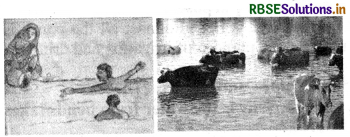
Answer:
No
Question 4.
Due to which reasons the drinking water sources are getting polluted?
Answer:
Due to bathing of animals’, washing of clothes, throwing trash, throwing of dead bodies of animals, not to maintaining proper cleanliness around these water bodies, etc. the drinking water sources are getting polluted.
Question 5.
Water from the drinking water sources should remain uncontaminated and safe. What efforts should be made in this regard?
Answer:
We should not throw any dirth or trash in them, from time to time cleanliness should be done. And in drinking water resources, we should not let animals enter.
Learnt, Understood, and Now Tell
Question 1.
Wells, step wells and are the sources of drinking water.
Answer:
hand pumps.
Question 2.
We get water supply for our house holds through taps and
Answer:
hand pumps.
Question 3.
A well is circular in shape and a step well is in shape.
Answer:
square.
Question 4.
Water is purified by filtration, boiling and
Answer:
through machines.
RBSE Class 5 EVS Sources of Water Important Questions and Answers
Objective Type Questions
Question 1.
Choose the right option.
(i) Medtani Bawadi (step well) is located in
(a) Jaipur
(b) Alwar
(c) Jhunjhunu
(d) Dausa
Answer:
(c) Jhunjhunu
(ii) Kola Barrage is built over-
(a) river Chambal
(b) river Maahi
(c) river Ganga
(d) none of these
Answer:
(a) river Chambal
Question 2.
Fill in the blanks :
(a) Earlier, people brought water from well, step well, pond, river etc.
(b) In the villages, there are of water works department.
(c) By drinking pure and clean water, many. can be prevented.
(d) To reach the water of step wells are constructed in them.
Answer:
(a) lake
(b) tanks
(c) diseases
(d) stairs

Question 3.
Match table A with Table B :
|
Table A |
Table B |
|
Well Step well |
Square Circular river |
|
Banswara Kota |
Chambal Maahi |
Answer:
|
Table A |
Table B |
|
Well Step well |
Ciruclar Square River |
|
Banswara Kota |
Maahi River Chambal |
Question 4.
State True/False :
(i) Wells and step wells are our water sources.
(ii) Dams are used for the purpose of irriga-tion, electricity generation, and as water sources.
(iii) There is no difference between wells and step wells.
(iv) Parachabawadi is located in Ramdevra.
(v) Water of an open pond is drinkable.
Answers :
(i) True
(ii) True
(iii) False
(iv) True
(v) False.
Very Short Answer Type Questions
Question 1.
Mention two sources of drinking water.
Answer:
- Hand pumps
- Wells
Question 2.
In villages, which department has built water tanks? '
Answer:
Waterworks Department has built water tanks in villages.
Question 3.
In Rajasthan who developed the enriched systems for the conservation of water?
Answer:
The kings, rulers and the public together.
Question 4.
Mention two methods of purifica¬tion of water.
Answer:
- Bioling
- by chemicals.
Question 5.
What is R.O. machine?
Answer:
This is a water purifier (purifying machine).
Question 6.
Where is Khinni Bawadi situated?
Answer:
In Jalore.
Question 7.
What is the depth of the Medtani Bawadi in Jhunjhunu?
Answer:
It is 150 feet deep.
Question 8.
Where is Chand Bawadi located?
Answer:
In Abhaneri.
Question 9.
Mention any two tises of dams.
Answer:
- Irrigation
- Electricity generation.
Question 10.
Mention any two rives of Rajasthan.
Answer:
- River Chambal
- River Maahi.
Short/Long Answer Type Questions

Question 1.
Mention 4 names of old (ancient) and new (modern) sources of drinking water.
Answer:
Old sources of water :
- Well
- Stepwell
- river
- lake.
New sources of water :
- Tap
- tank
- Hand pump
- Tube well.
Question 2.
Mention the sources of getting underground water.
Answer:
Hand pump, motor pump, tube well, etc. sources are the sources used to get under¬ground water. In ancient time, people used to get water from wells, step wells, etc.
Question 3.
Why should we drink filtered water?
Answer:
After filtration, water becomes pure and clean, so it prevents water-borne diseases such as vomiting, loose motions, etc.
Question 4.
Mention the features of the step wells in Rajasthan.
Answer:
Features of step wells in Rajasthan:
- Step wells are square-shaped.
- There are stairs on all the four sides of these step wells.
- These step wells fulfill religious and soul needs of people.
- Some step wells have peepholes and corridors.
Question 5.
Mention the names any four step wells of Rajasthan.
Answer:
- Parcha bawadi, Ramadevra
- Khinni Bawadi, Jalore
- Chandbawadi, Abhaneri
- Medtani Bawadi,Jhunjhunu.
Question 6.
Explain about the parcha bawadi of Ramdevra.
Answer:
The Parcha Bawadi of Ramdevra is very beautiful and artistic. Its water is considered veiy much sacred, so the pilgrims who visit the place, take its water along with them.
Question 7.
Explain the Medtani Bawadi of Jhunjhunu.
Answer:
The Medtani Bawadi of Jhunjhunu is very ancient, beautiful and artistic. Its depth is 150 feet. It was built in 1783. Many peepholes and corridors are there in this step well.
Question 8.
Where does the underground wa¬ter come from?
Answer:
Rainwater, by seeping, gets collected beneath the earth and is called groundwater.
Question 9.
How is irrigation made possible by constructing dams on rivers?
Answer:
Water of rivers is controlled by construction strong and large walls, then through canals the water is supplied to the agricultural fields.
Question 10.
Give a brief description of wells.
Answer:
Like step wells, wells are also major sources of drinking water and irrigation. Wells are circular shaped. Bricked walls are constructed around them so no animal falls into them. Even today, there are some wells without walls around them so we should access these wells carefully. Underground water is used to fill these wells. There are several methods of getting water from the wells. In Dundlod of Jhunjunu district, there is an ancient well of this type. On a square shaped platform (Chabutra) near the well, there are ar-tistic canopies, baradari to take rest, and there are four high minarates.
Practical
Question 1.
Look at the following picture and write down the steps of rainwater conservation
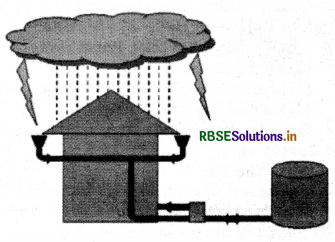
Answer:
Steps of the process of rainwater conservation :
- Rainwater falls on the terrace of the house.
- Drains of the terrace are connected to the pipes (of water conservation system).
- Through these pipes, water comes into the tank.
- The water gets filtered through the filters fixed in the pipes. This filtered (clean) water gets collected into the tank.
- The water collected in the tank is used for various domestic purposes and for agriculture.

Question 2.
Look at the picture and write down the methods of water purification.
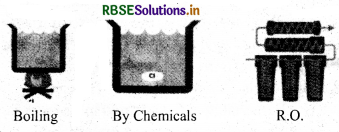
Answer:
Methods of water purification :
- Boiling, straining with the help of a cloth.
- Purification of water by chemicals.
- To purify water through machines (R.O. Plant etc.).
Questioning
Question 1.
Look at the picture of Maahi dam, and write down any three questions to get more information about it.

Answer:
- Where is Maahi dam situated?
- On which river Maahi dam is built?
- Mention any two advantages of Maahi dam.
Question 2.
Look at the picture of step well, and write down any three questions to get more information about it.
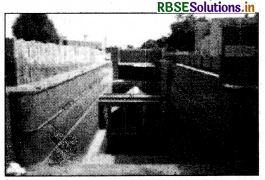
Answer:
- How do people reach the water of step well?
- Mention any two advantages of step well.
- Name any two ancient step wells in located Rajasthan.

Question 3.
Look at the picture of well, and to get more information
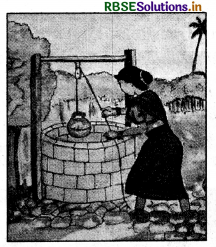
ation about it, write down any three questions.
Answer:
- What is the shape of wells?
- What is built on the square platform (chabutra) near the well?
- Mention any two advantages of a well.

- RBSE Solutions for Class 5 EVS Chapter 13 Let's Play with Water
- RBSE Solutions for Class 5 EVS Chapter 11 Life in Water
- RBSE Solutions for Class 5 EVS Chapter 12 Contaminated Water Spreads Diseases
- RBSE Solutions for Class 5 EVS Chapter 10 Flow of Water
- RBSE Solutions for Class 5 EVS Chapter 3 We are Special
- RBSE Solutions for Class 5 EVS Chapter 10 जल ऊपर से नीचे की ओर
- RBSE Solutions for Class 5 EVS Chapter 6 बीज बना पौधा
- RBSE Solutions for Class 5 EVS Chapter 7 Magnificence of Trees
- RBSE Solutions for Class 5 EVS Chapter 11 जल में जीवन
- RBSE Solutions for Class 5 EVS Chapter 6 Seed Becomes Plant
- RBSE Solutions for Class 5 EVS Chapter 8 The Unique World of Insects and Animals